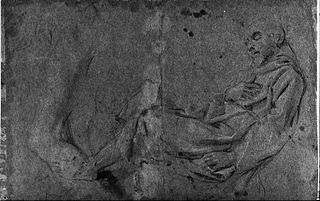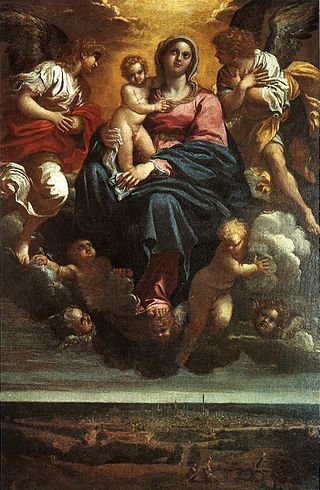
Agostino Carracci was an Italian painter, printmaker, tapestry designer, and art teacher. He was, together with his brother, Annibale Carracci, and cousin, Ludovico Carracci, one of the founders of the Accademia degli Incamminati in Bologna. Intended to devise alternatives to the Mannerist style favored in the preceding decades, this teaching academy helped propel painters of the School of Bologna to prominence.

Annibale Carracci was an Italian painter and instructor, active in Bologna and later in Rome. Along with his brother and cousin, Annibale was one of the progenitors, if not founders of a leading strand of the Baroque style, borrowing from styles from both north and south of their native city, and aspiring for a return to classical monumentality, but adding a more vital dynamism. Painters working under Annibale at the gallery of the Palazzo Farnese would be highly influential in Roman painting for decades.

The Carracci were a Bolognese family of artists that played an instrumental role in bringing forth the Baroque style in painting. Brothers Annibale (1560–1609) and Agostino (1557–1602) along with their cousin Ludovico (1555–1619) worked collaboratively. The Carracci family left their legacy in art theory by starting a school for artists in 1582. The school was called the Accademia degli Incamminati, and its main focus was to oppose and challenge Mannerist artistic practices and principles in order to create a renewed art of naturalism and expressive persuasion.

The Enthroned Madonna and Child with Saints is a triptych painting in tempera and gold leaf on panel by Agnolo Gaddi.

Archangel Michael fights the devil and the Virgin of the Assumption of the Angels is an oil painting on canvas of Dosso Dossi and Battista Dossi, dated to about 1533 to 1534 and preserved at the Galleria nazionale di Parma.

Madonna della Scodella is an oil painting on panel by Antonio da Correggio, dated from 1528 to about 1530 and preserved at the Galleria nazionale di Parma.

The portrait of Don Philip of Bourbon Family is an oil painting on canvas of Giuseppe Baldrighi, dated to about 1757 and preserved in the Galleria Nazionale Di Parma.
Lucrezia Scarfaglia was a Bolognese painter of the 17th century. Almost nothing is known of her life and career save that she was a pupil of Elisabetta Sirani, after whose death she took lessons with Domenico Maria Canuti. She was described by Carlo Cesare Malvasia as "not a mediocre painter". In his Felsina pittrice, Malvasia lists a number of works by Scarfaglia's hand, including a handful of religious works and a portrait of Eleanora Gonzaga. Her only known surviving work is a self-portrait, signed and dated 1678, in which she depicts herself painting the Madonna of Saint Luke. This piece is in an archaic style reminiscent of sixteenth century paintings; it is currently held by the Galleria Pallavicini in Rome.

Healing of the Man Born Blind is a c.1573 painting by El Greco, showing the healing the man blind from birth. It is now in the Galleria nazionale di Parma. It is signed at the bottom right-hand corner. It shows the artist returning to a theme he had first painted five years earlier, in a work now in Dresden.

Pietà is a c. 1600 oil on canvas painting by Annibale Carracci, the earliest surviving work by him on the subject, which was commissioned by Odoardo Farnese. It moved from Rome to Parma to Naples as part of the Farnese collection and is now in the National Museum of Capodimonte in Naples. It is one of many 16th century Bolognese paintings dedicated to the theme of the Pietà, and it is counted among Carracci's masterpieces.

Pope Paul III with a Nephew is an unfinished 1534 oil on slate portrait by Sebastiano del Piombo, now in the Galleria nazionale di Parma. The nephew's identity is unclear but the painting's presumed date suggests it may be Ottavio Farnese, whom Pope Paul III made Duke of Parma and Piacenza soon after the work's date

Mystic Marriage of Saint Catherine or Mystic Betrothal of Saint Catherine is a c.1524 oil on canvas painting by the Italian Renaissance painter Parmigianino. The work is now in the Galleria nazionale di Parma. Art historians argue that the work may be attributed to the period in which Parmigianino was painting his first works in the church of San Giovanni Evangelista, as also emerges from a recent restoration, which has shown that its technique is near-identical to that of Parmigianino - "no underdrawing, pigment use, descriptive speed, drafting of final shadows, using fingers and brush-ends as tools".

Christ in Glory with Saints and Odoardo Farnese or 'Christ in Glory with Odoardo Farnese and Saints Peter, John the Evangelist, Mary Magdalene, Hermenegild and Edward is a painting by Annibale Carracci. Placed in the Eremo di Camldoli either early in its life or straight after its creation, at the end of the 17th century Ferdinando II de' Medici moved it to the Galleria Palatina in Florence, where it still hangs.

The Funeral of the Virgin Mary is a 1605-1609 oil on canvas painting by Ludovico Carracci, now in the Galleria nazionale di Parma.

Madonna and Child with Saints, Madonna and Child Enthroned with the Infant St John the Baptist, St John the Evangelist and Saint Catherine of Alexandria or the San Giorgio Madonna is a 1593 oil on canvas painting by Annibale Carracci, originally in the Landini chapel in the church of San Giorgio in Poggiale, Bologna. During the 19th century the conservation conditions there worsened and it was moved to the Accademia di Belle Arti for restoration, before being moved to its current home in the then-new Pinacoteca Nazionale di Bologna.. It is signed and dated "ANNI CARR FE MDXCIII".

The Death of Saint Francis is the probable subject of two lost paintings by Annibale Carracci, both possibly dating to 1597-1598. One is known solely through a print and the other through a series of painted copies.

Madonna and Child in Glory over the City of Bologna is a c.1593 oil on canvas painting by Annibale Carracci, also known as The Virgin and Child in the Clouds or the Madonna of Bologna. It is now in Christ Church Picture Gallery in Oxford.

Pietà with Saints Clare, Francis and Mary Magdalene is a 1585 oil on canvas painting by Annibale Carracci, now in the Galleria nazionale di Parma.

Madonna and Child with Saints is an oil on canvas painting by Agostino Carracci, from 1585, dated on the lowest step of the Virgin Mary's throne. An example of a sacra conversazione. Long in the Benedictine abbey of San Paolo in Parma, French troops took it to Paris in 1796 and on its return to Italy in 1816 it was moved to the Galleria nazionale di Parma, where it still hangs.
Eugenio Riccomini was an Italian art historian. He died on 25 December 2023, at age of 87.


















